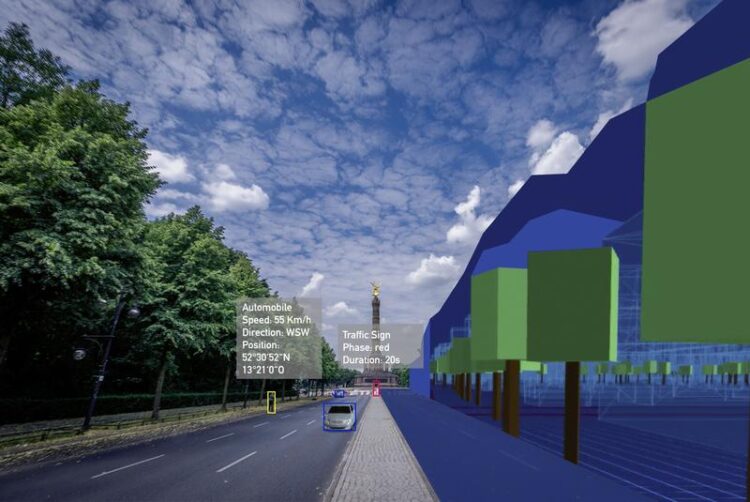Testing mobility scenarios with the Open-Source simulation environment Eclipse MOSAIC

The simulation environment Eclipse MOSAIC is now available as open source
Fraunhofer FOKUS
On the occasion of EclipseCon 2020, Fraunhofer FOKUS launches its simulation environment Eclipse MOSAIC. This solution is based on VSimRTI (Vehicle-2-X Simulation Runtime Infrastructure), which has been developed over the last 12 years in close cooperation with the DCAITI of the TU Berlin and has already been used by more than 600 partners to test mobility services and traffic scenarios. Eclipse MOSAIC is now partially available as open-source.
Whether dynamic lane assignment or traffic light phase assistant, new mobility services are designed to increase safety, efficiency, comfort, and facilitate environmentally friendly transport. The Eclipse MOSAIC simulation environment allows to explore how this can be achieved, before the services are tested in field trials on the road. Eclipse MOSAIC can also be used for testing driver assistance systems and to optimize the entire traffic.
Flexible coupling of simulators
Eclipse MOSAIC integrates, depending on the simulation scenario, different aspects like individual building blocks into a holistic system, e.g., traffic congestion, battery charging of electric cars, or communication between other road users and a central cloud. The level of detail for individual aspects is variable: from a rough mobility scenario for an entire city to detailed individual driving maneuvers.
The open-source version of Eclipse MOSAIC already includes several simulators, e.g., Eclipse SUMO for traffic and OMNeT++ and ns-3 for communication. Further simulators can be coupled, e.g., Fraunhofer FOKUS offers the simulator PHABMACS for the realistic modeling of autonomous vehicles.
In addition to the simulator coupling, Eclipse MOSAIC manages the following tasks:
· Federation: Individual simulators are interchangeable within a scenario.
· Interaction: Information from one simulator is also taken into account by others.
· Time: All simulators run synchronously.
Additionally, Eclipse MOSAIC offers several tools for evaluation and visualization of the results, which are also included in the open-source package.
In the recently completed EU project INFRAMIX, Eclipse MOSAIC was used to test scenarios for the future road that allow mixed traffic between conventional and automated vehicles.
Fraunhofer FOKUS has been a strategic development member of the Eclipse Foundation since May of this year and works in close cooperation with the partners of the working groups OpenMobility and openADx (Open Source for Autonomous Driving).
More information:
Eclipse MOSAIC:
https://www.eclipse.org/mosaic
https://github.com/eclipse/mosaic
INFRAMIX:
https://www.fokus.fraunhofer.de/de/fokus/news/inframix-projekt_2020_08
EclipseCon:
https://www.eclipsecon.org/2020
Press contact:
Fraunhofer Institute for Open Communication Systems FOKUS
Mitra Motakef-Tratar
Corporate Communications
Telephone: +49 30 3463-7517
mitra.motakef-tratar@fokus.fraunhofer.de
Image material is available for download:
https://owncloud.fokus.fraunhofer.de/index.php/s/IFCUop9whDTMNYt
Caption: The simulation environment Eclipse MOSAIC is now available as open source. Copyright: Fraunhofer FOKUS.
Fraunhofer FOKUS researches digital transformation and its impact on society, economics and technology. Since 1988 it supports commercial enterprises and public administration in the shaping and implementation of the digital transformation. For this purpose, Fraunhofer FOKUS offers research services ranging from requirements analysis to consulting, feasibility studies, technology development right up to prototypes and pilots in the business segments Digital Public Services, Future Applications and Media, Quality Engineering, Smart Mobility, Software-based Networks, Networked Security, Visual Computing und Analytics. With about 450 employees in Berlin and an annual budget of 33 million euros, Fraunhofer FOKUS is the largest ICT institute of the Fraunhofer Society. Around 80% of its budget is generated through projects from industry and the public domain.
Media Contact
All latest news from the category: Information Technology
Here you can find a summary of innovations in the fields of information and data processing and up-to-date developments on IT equipment and hardware.
This area covers topics such as IT services, IT architectures, IT management and telecommunications.
Newest articles

You are What You Eat—Stanford Study Links Fiber to Anti-Cancer Gene Modulation
The Fiber Gap: A Growing Concern in American Diets Fiber is well known to be an important part of a healthy diet, yet less than 10% of Americans eat the minimum recommended…

Trust Your Gut—RNA-Protein Discovery for Better Immunity
HIRI researchers uncover control mechanisms of polysaccharide utilization in Bacteroides thetaiotaomicron. Researchers at the Helmholtz Institute for RNA-based Infection Research (HIRI) and the Julius-Maximilians-Universität (JMU) in Würzburg have identified a…

ASXL1 Mutation: The Hidden Trigger Behind Blood Cancers and Inflammation
Scientists show how a mutated gene harms red and white blood cells. LA JOLLA, CA—Scientists at La Jolla Institute for Immunology (LJI) have discovered how a mutated gene kicks off…



